Bird Paradise
Have you ever wondered what tens of thousands of breeding birds look like? Well, take a trip to the tiny Isle of May and you are up for a treat. At the Firth of Forth, just off the coast of Fife stands the island that’s home to a fascinating wildlife. You can take the ferry (hoping for calm sea) and spend a day on this piece of protected land. On your way you may see some beautiful gannets diving for fish and soon be welcomed by the sound and smell of gulls, shags, kittiwakes, guillemots, razorbills, puffins and many more species of birds. As there’s no predator on the island, it is truly a bird paradise, where parents can raise their chicks in relative safety. Of course nesting on the narrow ledges might not be what one considers safe.
In addition to its importance as a Proteced Area, the island also serves as a site for the scientific study of marine birds and seals. Scientists have been monitoring the populations for decades, which allows them to evaluate the changes due to natural and anthropogenic causes. Most of the species are threatened by human activities mainly the overfishing of their prey and due to the effects of climate change.

Northern Fulmar (Fulmarus glacialis)



Northern Gannet (Morus bassanus)
Grey seal (Halichoerus grypus)

Razorbill (Alca torda)
These small black and white birds breed on steep cliffs and ledges along the coast in Northern Europe. Their diet consists of fish (sandeel, sprat and herring). They can dive up to 120 m depth and use their wings as flippers to propel themselves through the water. They spend most of their lives at sea and come to shore only during the breeding period to lay a single egg. Both members of the pair are involved in incubation, brooding and feeding. Later, however, it is the male that takes the chick to sea.


Common guillemot (Uria aalge)
Guillemots along with razorbills and puffins are part of the Auk (Alcidae) family. These birds are the ’penguins of the Northern Hemisphere’. They are all skilfull divers feeding on small fish, molluscs and crustaceans. They winter at sea and come to shore to breed when they aggregate in large colonies on steep cliffs to lay their eggs.
The female guillemot lays a single egg with a distinc pattern. They tend to come back to the same spot and produce an egg with the same pattern each year. After hatching both, the male and the female take part in the brooding. The chicks leave the nest before they can fly and have to take a leap from the cliffs to get to the water. They are then joined by the male, who takes them to the sea.


Atlantic puffin (Fratercula arctica)
Puffins are probably the most popular inhabitants of the island. Who wouldn’t immediately fall in love with these tiny birds flying back to their nest with their beaks full of sandeel. They nest colonially in burrows. Like other auks, they come to the island to breed and winter out at sea.



European shag (Phalacrocorax aristotelis)
Shags are related to cormorants, but they are somewhat smaller and have piercing green eyes. Also, cormorants occur around inland waters, while shags are entirely marine. Like the auks, they are good divers feeding mostly on fish like sandeel. They can be spotted after dives sitting on rocks drying their wings. They breed in colonies on cliffs along the coast and their nesting period is much longer than other birds’ on the island.
Gulls (Laridae)
The three species of gulls that live on the island belong to the Large white-headed gull group and it is quite tricky to tell them apart, especially when they are young. Gulls are common along the coast and even inland, so they should be familiar faces. They nest in colonies or in pairs. Their diet is diverse including fish, crustaceans, earthworms and even roadkill and the eggs or young of other birds. Herring gulls and great black-backed gulls winter on the island, while the lesser black-backed gulls are long-distance migrants and leave to Africa.




Common eider (Somateria mollissima)
Eider ducks nest close to the water on the shore and dive for crustaceans and molluscs to feed on. The female has dark brown plumage with a pattern that helps camouflage. Males, on the other hand, are black and white with a small pale green patch. During the incubation period females do not leave the nest to feed to avoid predation. Therefore, after hatching they rush to the water, but don't worry the chicks are in good hands. Non-breeding female relatives look after them.

Arctic tern (Sterna paradisaea)
There are two species of terns on the island: common and arctic terns. They may be small, but they are tenacious birds. Arctic terns have one of the longest migration routes of all birds. They arrive in summer and winter off in Africa or Antarctica. They nest on the ground and viciously protect their nest, so you better watch out when entering their nesting territory.







